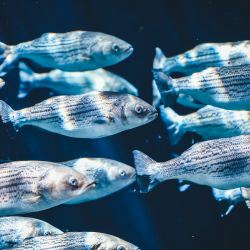Fish + bacteria = 25% mortality.
Fish + bacteria + rocks = 5% mortality.
What magic lies within the rocks? What can farm-raised fish teach us?
One of the lessons of the pandemic has been how where we live influences our susceptibility to disease. While we often categorize our local environment as rural or urban, single-family homes or apartment, these are all manifestations of our “built” environment. An environment we construct for ourselves and therefore can alter. If only we understood how it changes us. For that, we need to look no further than an experiment with farm-raised fish.
Aquaculture is becoming more and more important to us. Fish farming is a growing source of food, and it suffers from some of the same problems with associate with “factory farming,” overcrowding, and disease. Infectious disease not only can severely reduce “yields” and therefore efficiency, raising cost, but is a sign that we are not the good shepherds we wish to be. The built environment of fish farms is bland, a single fish species (monoculture), at a high population density, frequently a tank that has been cleansed of all but water, creating a high level of hygiene. The visceral response in the face of disease is to throw antibiotics at it, which increases antibiotic resistance, a growing problem. Could changing the environment alter outcomes?
The researchers infected “sea-migrating brown trout (Salmo trutta) and landlocked Atlantic salmon (Salmo salar m. sebago)” with a bacteria, Flavobacterium columnare, which is directly transmitted between fish and is considered a significant pathogen. The fish were exposed to the pathogen in their water for an hour, and then the water flushed out and replaced by the farm’s natural water flow from a lake. The change in the built environment was simply the addition of some rocks. [1] In one experimental condition, the stones were scrubbed clean; in the other, rocks spent a day “conditioning” in the lake water. Here are their results:

The top graph depicts the survival of the trout, the bottom graph, the salmon. The experiment was carried out over roughly five days. Look first at that solid line, the control group, living in their tank filled only with water. 25% of the trout died, 90% of the salmon. [2] In essentially every case, the addition of rocks, 6 or 60, scrubbed or conditioned in the lake, resulted in fewer deaths. What magic could rocks provide to increase survival from 75 to 95% or 90 to 93%?
- Conditioning seemed to help, that is, introducing “healthy” bacteria into the environment from the biofilm coating the stones.
- More stones seemed to work better than fewer ones.
- More stones altered the behavior of the fish. Absent stones or with few, the fish tended to school, gather together, significantly reducing their social distancing. With many rocks, the fish tended to separate, becoming solitary. As the researcher point out, the shedding of bacteria by the ill exposes more fish when they are more tightly packed.
- The additional “personal” space afforded by the rocks is also felt to reduce the stress on fish. Stress is a known problem for factory-farms.
“To conclude, we found that even a simple environmental enrichment can reduce the effect of diseases in aquaculture environment.”
We, too, are animals susceptible to alterations in our built environment. How closely we “school” affects our health. The ability to spend less time tightly packed because of pedestrian-friendly streets, pocket parks, or even Central Parks may well affect our stress levels. There are differences between rural, suburban, and urban that are not well captured in population density, housing size, or income. Fish do not “recognize” that they swim in the water; it is a given; we do the same with our built environment. But with a bit of understanding afforded us by science and the foresight to use that information to our advantage, we may find that we set ourselves up for a healthier life; and not find ourselves like “fish out of water.”
[1] The built environment consisted of 15-gallon tanks with 100 fish. The fish were early in their growth, only about 1.5” in size.
[2] The disparities in survival have to do with a greater virulence of the bacteria in trout and a slower disease course in salmon.
Source: Quantity and Quality of Aquaculture Enrichments Influence Disease Epidemics and Provide Ecological Alternatives to Antibiotics Antibiotics DOI: 10.3390/antibiotics10030335

